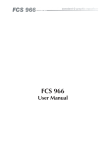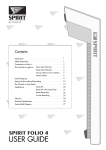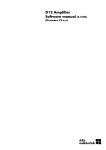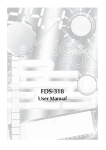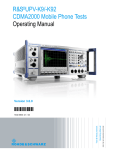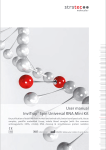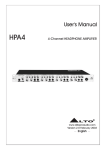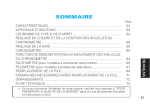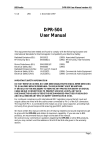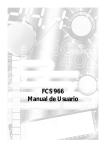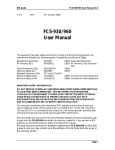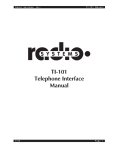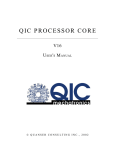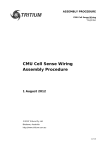Download Manual
Transcript
FCS 966 User Manual 1 V 1.0 BV/JMK 30 April 1998 An example of this equipment has been tested and found to comply with the following European and international Standards for Electromagnetic Compatibility and Electrical Safety: Radiated Emissions (EU): EN55013 RF Immunity (EU): EN50082/1 Mains Disturbance (EU): EN61000/3/2 Electrical Safety (EU): EN60065 Radiated Emissions (USA): FCC part 15 Class B (1990) Associated Equipment (1992) RF Immunity, Fast Transients ESD (1995) (1993) IMPORTANT SAFETY INFORMATION DO NOT REMOVE COVERS. NO USER SERVICEABLE PARTS INSIDE, REFER SERVICING TO QUALIFIED SERVICE PERSONNEL. THIS EQUIPMENT MUST BE EARTHED. IT SHOULD NOT BE NECESSARY TO REMOVE ANY PROTECTIVE EARTH OR SIGNAL CABLE SHIELD CONNECTIONS TO PREVENT GROUND LOOPS. ANY SUCH DISCONNECTIONS ARE OUTSIDE THE RECOMMENDED PRACTISE OF BSS AUDIO AND WILL RENDER ANY EMC OR SAFETY CERTIFICATION VOID. For continued compliance with international EMC legislation ensure that all input and output cables are wired with the cable screen connected to Pin 1 of the XLR connectors and/or the jack plug sleeve. The input XLR Pin 1, input jack socket sleeve and Combi-Con screen connectors are connected to the chassis via a low value capacitor, providing high immunity from ground loops whilst ensuring good EMC performance. Please read We have written this manual with the aim of helping installers, sound engineers and musicians alike to get the most out of the FCS 966. We recommend that you read this manual, particularly the section on installation, before attempting to operate the unit. We recommend that you read this manual, particularly the section on installation, before attempting to operate the unit as there are a number of features that may not be apparent by casual use. The manual is split into two main sections. The first contains quick reference information, regarding the functions and operation of the unit, while the second covers a more general background to the uses and application of the FCS 966. We welcome any comments or questions regarding the FCS 966 or other BSS products, and you may contact us at the address or World Wide Web site given in the warranty section. 2 Contents Contents 1.0 Mechanical installation 5 2.0 Unpacking 6 3.0 Mains Power Connection Mains Power 6 6 4.0 Introduction 7 5.0 5.1 5.2 5.3 5.4 5.5 Audio Connections XLR Inputs XLR Outputs Jack Inputs Jack Outputs Combi-Con connectors 10 10 10 11 12 12 6.1 6.2 6.3 6.4 6.5 6.6 6.7 6.8 Control operations Eq In Gain HP Filter LF Contour HF Contour Output meter Clip indicators Frequency band sliders 14 14 14 15 15 16 16 17 17 7.1 7.2 7.3 General guide to equalisers What is a graphic? How do I use it? What does constant Q mean? 18 18 18 19 3.1 6.0 7.0 3 Contents 8.0 8.1 8.2 8.3 8.4 8.5 8.6 9.0 10.0 4 Application examples General Equalisation problem solving Feedback reduction Room equalisation Uses for the HP Filter Uses for the LF contour Use for the HF contour 21 Warranty Information 25 Specifications 26 Index 27 User Notes 28 Spare Parts Information 31 21 22 22 23 24 24 Mechanical Installation 1.0 Mechanical installation A vertical rack space of 3U (5 1/4" - 133.5mm high) is required, with a depth of 190mm, excluding connectors. Ventilation gaps are unnecessary. If the unit is likely to undergo extreme vibration through extensive road trucking and touring, the unit must be supported at the rear and/or sides to lessen the stress on the front mounting flange. The necessary support can generally be bought ready-built, as a rack tray, or the FCS 966 can be mounted between other units. Damage caused by insufficient support is not covered by the warranty. To prevent cosmetic damage to the front panel paint finish, always use protective plastic cups under the rack mounting bolts. As with any low-level signal processing electronics, it is best to avoid mounting the FCS 966 next to a strong source of magnetic radiation or heat, for example, a high power amplifier. Fig 1.1 Unit dimensions. Fig 1.2 Rack dimensions. 5 Unpacking Mains Power Connection 2.0 Unpacking As part of the BSS system of quality control, we check every product carefully before packing to ensure that it reaches you in flawless condition. Before you go any further, please check the unit for any physical damage and retain the shipping carton and all relevant packing materials for use, should the unit need returning. In the event that damage has occurred, please notify your dealer immediately, so that a written claim to cover the damages can be initiated. Check out section 9.0; warranty information, for more info on the warranty, and also to record your dealer details. 3.0 Mains Power Connection 3.1 Mains Power WARNING! THIS APPLIANCE MUST BE EARTHED. The FCS 966 must always be connected to a 3-wire earthed AC outlet. The rack framework must also be connected to the same grounding circuit. The unit must NOT be operated unless the power cables' EARTH (ground) wire is properly terminated - this is important for personal safety as well as for proper control over the system grounding. The wires in the mains lead are colour coded in accordance with the following code. Green and Yellow......Earth Blue......Neutral Brown......Live Those units supplied to the North American market will have an integral moulded 3 pin connector which is provided to satisfy required local standards. IMPORTANT: The FCS 966 is designed to use 50/60Hz AC power in one of two voltage ranges, selectable with the mains voltage selector switch on the rear of the unit. It is vital that the position of this switch is checked BEFORE initial power up to ensure that it matches the local mains supply. Acceptable input AC supply voltages range from: 115V switch position 230V switch position 90V to 132V 190V to 265V The application of voltages outside these ranges may cause permanent damage or erratic operation of the unit, and will invalidate the warranty. The mains fuse carrier on the rear of the unit must be fitted with the correct type and rating of fuse, depending on the position of the mains voltage selector switch: 115V switch position 230V switch position T315mA fuse T200mA fuse In the unlikely event of the mains fuse failing without good reason, DISCONNECT THE UNIT FROM THE MAINS SUPPLY, and always replace 6 Introduction with the appropriately rated fuse (as specified previously) for continued protection against damage and fire. Note: For USA and Canadian users, the replacement fuse must be of an identical UL rated type fuse for continued compliance with safety standards. 4.0 Introduction The FCS 966 is a two channel graphic equaliser that provides a generous +/ -15dB of control range on each of 30 constant Q frequency bands. For optimum performance, each filter band is arranged to be out of circuit if it's sliders are left in the centre of its travel, and thus does not contribute unnecessary noise or distortion. In addition, a sweepable high pass filter, variable gain, and HF/LF contour controls are provided for extra flexibility. Indication of level is provided by an 8 segment meter that reads input level when the unit is bypassed, and output level when active. This allows accurate level matching of the equalised to unequalised signal. Indication of overload is provided by a separate clip indicator that simultaneously monitors the level at three critical internal points to ensure that any overload does not go unnoticed. When bypassed, the FCS 966 connects the output directly to the input with a high quality relay, ensuring that a signal passes even with a loss of AC power. The relay drive also incorporates a power on delay and AC power loss detector, ensuring that there is no possibility of on/off thumps being generated by the unit. For installation flexibility, XLR, Jacks and pluggable terminal block (combi-con) connectors are provided as standard, with transformer isolation on both the inputs and outputs available as an option. The mains lead is a standard detachable IEC type. 7 The FCS 966 Fig 4.1 Front Panel Fig 4.2 Rear Panel 8 All numbers in bubbles refer to Section numbers. 9 Audio Connections 5.0 Audio Connections 5.1 XLR Inputs There are 2 input sockets on the rear panel of the FCS 966; Input 1 and 2. Each is electronically balanced on standard 3 pin female XLRs at an impedance greater than 10k Ohms. The ‘HOT, +, or in phase’ connection is to pin 2 and the ‘COLD, -, or out of phase’ connection is to pin 3. Pin 1 is internally connected to the chassis earth via a low value capacitor. This ensures freedom from ground loops whilst allowing good EMC performance. The screen of the input cable should be connected to pin 1 to ensure that EMC regulations are being met, and the cable shield ground should also be connected to the equipment which is providing the input signal. Fig 5.1 966 When feeding the FCS 966 from unbalanced sources, connect the signal conductor to pin 2 and the cable screen to pins 1 and 3. Transformer isolated inputs are available as a dealer fitted option. Fig 5.2 966 5.2 XLR Outputs The output signals are electronically balanced and fully floating. Full headroom is available into any load of 600 Ohms or greater. The signal ‘HOT, +, or in phase’ signal is to pin 2, the ‘COLD, -, or out of phase’ signal is to pin 3, with pin 1 being connected directly to the chassis. Fig 5.3 966 10 When using the FCS 966 to drive unbalanced inputs, best performance is usually obtained by connecting the FCS 966s ‘+’ signal to the equipment signal pin and the ‘-’ signal to the equipment shield. Fig 5.4 966 The FCS 966 shield should normally be connected to the equipment shield, preferably at the equipment end. Transformer isolated outputs are also available as a dealer fitted option. 5.3 Jack Inputs The jack inputs are electrically identical to the XLR inputs. The ‘HOT, +, or in phase’ connection is to the jack plug tip, the ‘COLD, - or out of phase’ connection to the ring. The shield is internally connected to the chassis earth via a low value capacitor. This ensures freedom from ground loops whilst allowing good EMC performance. The screen of the cable must be connected to the jack plug shield to ensure continued compliance with EMC regulations. The cable shield ground should be connected to the equipment which is providing the input signal. Fig 5.5 966 Jack Input When feeding the FCS 966 from unbalanced sources, connect the signal conductor to the jack plug tip and the cable screen to the plug ring and shield. Fig 5.6 966 Jack Input 11 Audio Connections Control operations 5.4 Jack Outputs The Jack outputs are electrically identical to the XLR outputs. The signal ‘HOT, +, or in phase’ signal is connected to the jack plug tip. The ‘COLD, -, or out of phase’ signal is connected to the ring with the shield being connected directly to the chassis. Fig 5.7 966 Jack Output Connection to unbalanced inputs may be done by connecting the tip to the signal input, and the ring to the input shield. The FCS 966 shield may or may not be connected to the equipment shield at the equipment end. Fig 5.8 966 Jack Output 5.5 Combi-Con connectors Each channel of the FCS 966 is fitted with a six way pluggable terminal block or ‘Combi-Con’ connector. This connector carries both the balanced input and balanced output signals for that channel. The signals are electrically identical to those on the XLR connectors. For convenience it may be desired to use individual 3 way plugs for independent connection of input and output signals wired as follows: Fig 5.9 Fig 5.10 12 When feeding the FCS 966 from unbalanced sources, connect as follows. Note the link between the two end pins. Fig 5.11 When feeding the FCS 966 to unbalanced sources, connect as follows. Note the link between the two end pins. Fig 5.12 13 Control operations 6.0 Control operations 6.1 Eq In When the eq in switch is in the out, non illuminated position, all FCS 966 functions are bypassed and the input is connected directly to the output with a high quality relay. This condition also occurs when the power is off, and ensures that the signal is passed through the unit in the case of a power or fuse failure. When the switch is pressed, the processed signal is present on the output. When in this EQ bypass mode, the input is still connected to all of the FCS 966 circuitry, so that all of the required facilities can be selected and set up prior to operating the eq in switch and going ‘on-air’. Note that the output meter monitors the input signal when the channel is in bypass mode. 6.2 Gain This control allows the signal level at the output of the unit to be raised by up to 10dB, or alternatively completely attenuated. Around the ‘zero’ position the effect of the control is finer, allowing easy level matching of the equalised to unequalised signals. More extreme settings allow the gain control to be used as the main system level control. This is useful if there is more than one FCS 966 on the output of a signal source, each feeding a separate zone that require different levels. An extra feature of the control is that it allows the signal to be completely muted, again useful both during setting up and operation. 14 6.3 HP Filter Rotating this control clockwise progressively removes low frequency program material, which is useful for controlling sub-sonic signals that otherwise could cause overload problems. Judicious use of this control may allow more boost to be applied with the main graphic section, as unwanted lower frequencies are removed before the main signal is boosted. The HP filter may also be used to restrict the bass signal applied to loudspeakers that are unable to handle low frequencies, for example small drivers used in a bar or restaurant. If the HP filter is not required, the control should be left fully counterclockwise. 6.4 LF Contour This control applies a gentle, musical, low frequency boost and cut shelving response. It works in addition to the main graphic and provides a convenient way of changing the overall sound balance without disturbing a detailed room or speaker response that has been set up on the main equaliser section. One way to think of the LF contour control is as a means of augmenting the main equaliser in a way that can be easily adjusted and reset. 15 Control operations 6.5 HF Contour This control serves a similar purpose as the LF contour, but applied to higher treble frequencies. The HF contour control allows a subtle change to be made to the shape of the sound without affecting the previously configured main equaliser. On a creative note, the HF contour control can be used to breath ‘air’ into an otherwise flat sound, or remove ‘brittleness’ from over bright signals. 6.6 Output meter This is a peak reading RMS calibrated meter. Normally when the eq in buttons are depressed, it measures the signal being sent to the output connector. If the channel is bypassed (eq in button out), the meter reads the input signal. This allows accurate matching of the equalised and ‘dry’ signals using the gain control. 16 6.7 Clip indicators There are three critical places in the signal path of the FCS 966 that are monitored by the clip indicator circuit; if one or more of these overloads, the indicator is illuminated. These three places are: the output of the contour section, the output of the main equaliser section, and the output from the gain control section. Three point monitoring is required as it is easy to place the controls in positions that allow the overload of one section without this being obvious on the meter. The clip indicator provides instant confirmation that no part of the FCS 966 is being headroom compromised. 6.8 Frequency band sliders The main function of the FCS 966 is controlled with the frequency band sliders, which split the audible spectrum into thirty independent bands, centred on standard ISO frequencies. Each band may be amplified (boosted) or attenuated (cut) by up to 15dB, allowing great control over the program for either corrective or creative purposes. Normally, such a large control range on each slider could cause problems if the unit was being used for fine control. This is not a problem with the FCS 966 sliders, which provide a fine level of control near the centre or ‘zero’ position, progressively getting more aggressive as the control is advanced towards the ends of the travel. Thus both fine, musical adjustments and radical audio surgery are possible without operational compromise. When the slider is in the central position it is effectively out of circuit. 17 General guide to equalising 7.0 General guide to equalisers 7.1 What is a graphic? The graphic equaliser is one of the most common pieces of signal processing equipment. It finds uses both in recording environments and live performance, as well as sound reinforcement and noise pollution control. The graphic equaliser is a very powerful tool, and as with all powerful devices caution should be exercised or problems will occur. A graphic equaliser operates by splitting the audio signal into a number of individual bands; in the case of the FCS 966, 30 bands. As each of the ten musical octaves that make up the audio spectrum is split into 3 bands, the FCS 966 is termed a ‘third octave equaliser’. The frequency or pitch of each frequency band is printed on the front panel, between the rows of sliders. Each frequency slider allows signals that fall in that band to be individually raised (boosted) or lowered (cut) in level. The maximum amount of boost or cut is indicated adjacent to the sliders and in the case of the FCS 966 is +/-15dB or 30dB overall. 30dB corresponds to a change in level of approximately 32 times. If the slider is in the centre, zero position, signals in that band are unaffected. 7.2 How do I use it? As there is individual control of each frequency band, the signal can have its tonal quality and balance totally altered. As a general rule the sliders on the left 20% of the graphic have affect on the bass sound, with the right 20% affecting the treble. The sliders towards the centre, around 1kHz, affect the presence or midrange. Fig 7.1 The effect of sliders on different instruments 18 Figure 7.1 shows very approximately the sliders that have most effect on some common instruments - having an effect is related to the harmonic richness of the sound. A flute for example, generating relatively pure tones, will only have energy in a small number of bands at a given time, whereas a guitar has harmonics covering most bands. When applied to the guitar, the equaliser will be capable of completely changing the sound. A graphic equaliser may be used for both creative and corrective use. Both these uses can apply to whole sound systems or individual instruments. When used creatively, it may be set to change the timbre of an instrument and so alter its character. Used in a corrective manner, maybe on the same instrument, it can be used to remove a resonance that is making the instrument sound muddy or shrill. Graphic equalisers are also used extensively to treat the human voice and, by 'flattening' irregularities, can improve the perceived quality of inexperienced performers. Generally creative uses utilise gradual changes with small differences in position between adjacent sliders. Radical corrective surgery is usually indicated by larger adjustments to individual sliders, thereby treating the problem whilst leaving all other areas unaffected. See section 8 for some examples. 7.3 What does constant Q mean? The ‘Q’ of a filter is a technical term which corresponds to the measurement of its width, hence the term constant Q implies that as a slider is moved, the Q or width of the applied filter stays the same - refer to figure 7.2. Fig 7.2 difference between constant and non-constant Q sliders If the width varies with slider position, as it does with non constant Q equalisers, accurately summing the result from a number of sliders will be impossible except at one position, the position when the Q or width equals the space between two adjacent bands. It should be self evident that this type of operation is highly undesirable, as the effect of one slider will depend on the position of many others making the total effect unpredictable. 19 General guide to equalising Fig 7.3 gyrator type response Fig 7.4 constant Q response In line with it’s other graphic equalisers, BSS have chosen a ‘constant Q’ topology for the FCS 966, as this gives the best correlation between the actual slider positions and the measured response of the unit. Figure 7.4 shows how the response of the FCS 966 follows much more closely the curve depicted by the sliders than a gyrator based graphic (figure 7.3). Note that the illustration is a guide only. With the increasing use of acoustic analysis equipment for setting up sound systems, it is important that the graphic equaliser is as ‘what you see is what you get’ as possible. With other equaliser topologies, moving one slider can have a surprising effect on frequencies that are far from those being adjusted. This is also why some non constant Q equalisers can sound ‘phasey’ when they are being adjusted. 20 Application examples 8.0 Application examples Each of the following application examples is accompanied by a front panel control diagram. Controls that are not greyed out should be set to the value shown - refer to the text where no initial setting is shown. Those controls which are greyed out can be set to any value, and are not critical to the example. Settings can apply to both channels, but only one is shown here for clarity. 8.1 General Equalisation problem solving Generally when using an equaliser, you should think in terms of removing problem sounds rather than increasing the level of the good parts. The FCS 966 would normally be patched into the ‘insert’ point of the mixer channel carrying the signal that needs attention. Start with all the frequency sliders in the ‘zero’ position. Listen carefully to the program, and by experimentation, move groups of sliders until you find the general area of the problem. In turn increase the level of one slider at a time until you find the one that seems to aggravate the sound most. Bear in mind that any increase made will probably make the total sound worse; try to listen only to the aggravating sound - try to ignore the other effects. When the precise slider has been located, listen carefully and slowly start to cut that band. Stop reducing the level when the irritation stops. This may need to be repeated a number of times on different bands, but always be aware that it is very easy to ‘over eq’ the signal. The same procedure can be followed if it is required to boost certain parts of the program, however always bear in mind that use of excessive boost will compromise the system headroom and may overload following devices in the audio path. For creative use, it is generally better to get the sound you want by cutting. If the required cutting leads to a significant drop in overall signal level, this can be made up with the gain control. 21 Application examples 8.2 Feedback reduction This is one of the major uses for graphic equalisers in sound reinforcement applications. The FCS 966 would usually be connected either to the mixer ‘mix insert’ points, or between the output of the mixer and the input of the amplifier or crossover. Set all frequency bands to ‘zero’. With the room quiet and the offending microphone active, increase the system gain slowly (the FCS 966 gain control is convenient for this) until the system starts to howl. Be prepared to back off the gain quickly to stop this getting out of hand. Carefully set the gain such that the system is gently feeding back. Find the frequency band that corresponds to the tone that you are hearing, and move this slider fully down; the feedback should stop. Increase the system level and feedback will return, find the next offending frequency band and again reduce it, this time though only half way. Repeat this again, reducing the slider again to the half cut position. Increase the gain once more, on this occasion though only reduce the band by 25%. The graphic should now look something like figure 8.1. With four bands adjusted, there is probably not much merit in continuing, as the sound will start to be adversely affected. Fig 8.1 using the graphic for feedback reduction 8.3 Room equalisation For this, two other pieces of equipment are required: a pink noise source, and an acoustic real time analyser (RTA). With the FCS 966 interposed between the mixer and amplifiers, with all sliders set to ‘zero’, apply pink noise to the system at a level similar to that expected during normal operation. Observe that the RTA has a number of bars or a line that indicates the sound level in different parts of the spectrum. Adjust the FCS 966 so that the RTA indicates as flat a response as possible. If you are lucky, the RTA will have frequency bands marked the same as the FCS 966. 22 Be aware that making the system ‘flat’ by applying large amounts of boost is not desirable; when real program is applied to a system setup this way, overload is almost certain to occur. It is far better to reduce the level of peaks than try to fill in large holes. Be cautious also of pushing a speaker, particularly a bass speaker, to reproduce sounds which it is not capable of. This just leads to extra distortion. The extra heat and cone movement may also permanently damage the driver. Fig 8.2 using the graphic with RTA 8.4 Uses for the HP Filter It is highly undesirable to send large amounts of low frequency energy to speaker systems that are unable to cope with it. This leads to distortion and premature overload. As the HP filter is steep, it is able to more effectively remove this energy than the main equaliser low frequency bands. In addition to cleaning up the sound this may well enable the low frequency controls of the main equaliser to be used more creatively, as they do not now need to be employed to deal with sub-bass. Because power absorbing low frequency content has been removed, it may be possible to turn up the gain beyond the point that previously resulted in system overload. One major application for the HP filter is for removing the bass signals from monitor wedges designed for vocalists. As it may also be required to use one monitor mix for more than one performer, the HP filter provides a convenient method of effectively removing inappropriate signals from individual monitor feeds. 23 Application examples 8.5 Uses for the LF contour As the contour controls are gentle in operation, they are intended to be used whenever it is desired to change the tonal balance of the sound without disturbing the main equaliser settings. The LF contour control has many uses, but one particular application concerns small PA systems and presentations that contain both pre-recorded material and live presentations. It is often necessary to use slightly different amounts of bass for each type of program to avoid, for example, the presenter sounding particularly boomy, or the pre-recorded material sounding flat. The single contour control is ideal for this. On larger systems it may become necessary to slightly alter the weight of the bass content to correct for differences between the sound check and the actual live performance. Under these circumstances, great care will usually have been exercised setting up the main equaliser section during rehearsals to compensate for room acoustics etc. and it is highly undesirable to alter these. Adjusting the LF contour control provides a simple solution. Using the HF Filter in conjunction with LF contour provides a very powerful combination for adding 'weight' to small systems without causing sub-sonic overloads. 8.6 Use for the HF contour Like the LF contour control, HF contour should be regarded as a way of musically changing the tonal balance of the FCS 966. A common problem encountered in live sound applications is the drop in treble level that occurs when an audience is present. Heat and humidity can also alter the level of treble during a performance. Advancing the HF contour control is a unique and ideal way of dealing with this effect. Sometimes during a performance the complete opposite occurs, namely an excess of high frequencies. This is caused by the performers becoming more exuberant as the evening progresses. If left unchecked, this higher than expected level can easily cause distortion and listener fatigue. Without disturbing the main equaliser section, reducing the level of the HF contour allows subtle control of this phenomenon. 24 Warranty Information 9.0 Warranty Information When sold to an end user by BSS Audio or a BSS Audio Authorised Reseller, this unit is warranted by the seller to the purchaser against defects in workmanship and the materials used in its manufacture for a period of one year from the date of sale. Faults arising from misuse, unauthorised modifications or accidents are not covered under this warranty. No other warranty is expressed or implied. If the unit is faulty it should be sent to the seller of the equipment, in its original packaging with shipping prepaid. The unit will be returned to you when the repair has been completed. If the unit was purchased in the European Union, you may, as an alternative, return the unit to any other BSS distributor in the European Union. You should include a statement listing the faults found. The unit’s serial number must be quoted in all correspondence relating to a claim. IMPORTANT We recommend that you record your purchase information here for future reference. Dealer Name: Dealer Address: Post/Zip Code: Dealer Phone No.: Dealer Contact Name: Invoice/Receipt No.: Date of Purchase: Unit Serial Number: In keeping with our policy of continued improvement, BSS Audio reserves the right to alter specifications without prior notice. The FCS 966 was designed and developed by BSS Audio, Hertfordshire, England. Phone (+44) (0)1707 660667. Fax (+44) (0)1707 660755. World Wide Web address: http://www.bss.co.uk 25 Specifications 10.0 Specifications General Input Impedance Input Headroom Max Output level Output Impedance Frequency Response Noise Dynamic Range Cross Talk Distortion GAIN control HP filter control LF contour HF contour FREQUENCY bands 10kOhm balanced or unbalanced >+20dBu >+21dBu into 600 ohms or greater <50 Ohms unbalanced or unbalanced <5Hz to >45kHz +/-1dB <-94dBu 22Hz to 22kHz > 115dB <-80dB @1kHz <0.005%THD (80kHz measurement BW) 20Hz-20kHz, 0dBu +10dB to -infinity OUT to 250Hz @ 12dB/octave +/-6dB shelving @ 50Hz 6dB/octave +/-6dB shelving @ 14kHz 6dB/octave +/-15dB on ISO centres with a Q of 4 HP filter set to OUT. Gain, HF, LF & all sliders set to 0. Note that the filters are removed from the signal path when the slider is in the central 'zero' position. 26 Index Index C Clip indicator Connection mains power Connections Combi-Con Jack XLR Constant Q Contour HF LF I 17 6 12 11 10 19 16 15 D Dimensions 5 E EQ general In 21 14 8 8 17 19 18 20 22 17 8 6 14 LF Contour uses for... 15 24 M Mains power Output meter Outputs Combi-Con Jack XLR 6 16 24 15 23 16 12 12 10 R Rack space Rear panel Room equalisation 5 8 22 S Specifications 26 U 6 V Voltage selection H HF Contour uses for... HP Filter uses for... 5 7 L Unpacking G Gain 12 11 10 O F faces front rear Sliders constant Q effect on..... gyrator based Feedback reduction Frequency band sliders Front panel Fusing Inputs Combi-Con Jack XLR Installation mechanical Introduction 6 W Warranty Information 25 27 User Notes 28 29 User Notes 30






























